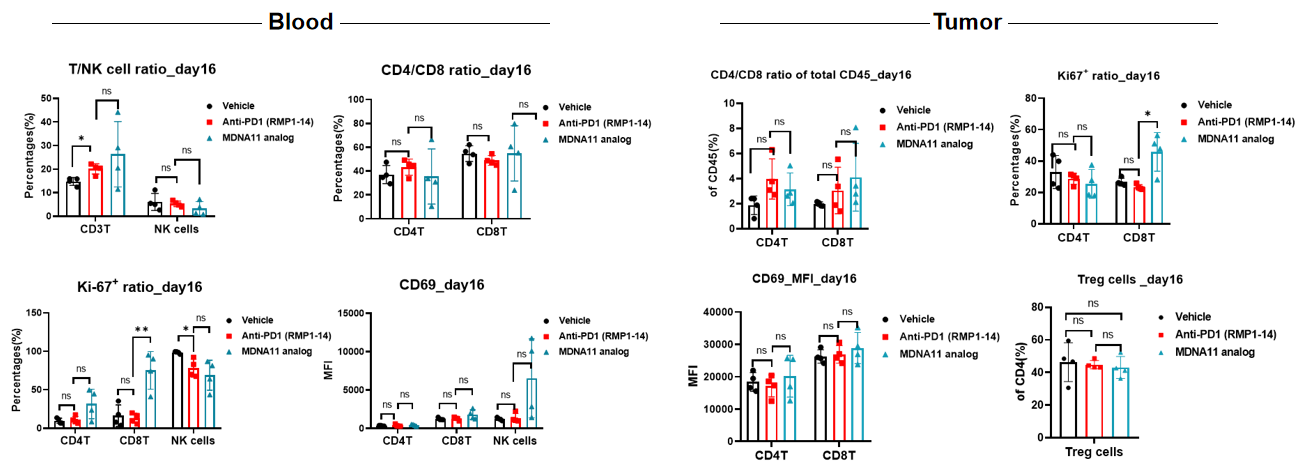


C57BL/6-ll2RBtm2(IL2RB)BcgenIl2RGtm2(IL2RG)BcgenIl15tm1(IL15)BcgenIl15RAtm1(IL15RA)Bcgen/Bcgen • 111866
| Product name | B-hIL2RB/hIL2RG/hIL15/hIL15RA mice |
|---|---|
| Catalog number | 111866 |
| Strain name | C57BL/6-ll2RBtm2(IL2RB)BcgenIl2RGtm2(IL2RG)BcgenIl15tm1(IL15)BcgenIl15RAtm1(IL15RA)Bcgen/Bcgen |
| Strain background | C57BL/6 |
| Aliases | IL2RB: CD122, IL15RB, IMD63, P70-75IL2RG: CD132, CIDX, IL2RG, IMD4, P64, SCIDX, SCIDX1IL15RA: CD215 |
B-hIL2RB/hIL2RG/hIL15/hIL15RA mice was obtained by crossing B-hIL2RB/hIL2RG mice with B-hIL15/hIL15RA mice. The targeting strategy of each gene are as follows. Exons 2~8 of the mouse Il2rb gene, which encodes the extracellular domain, were replaced by human IL2RB counterpart gene sequences. Exons 1~8 of the mouse Il2rg gene that encodes the full coding region sequences were replaced by human IL2RG exons 1~8. The mouse Il15 gene that encodes the full coding sequence was replaced by human IL15 counterpart gene sequences. The mouse Il15ra gene that encodes the extracellular region was replaced by human IL15RA counterpart gene sequences.

Strain specific IL2RB and IL2RG expression analysis in homozygous B-hIL2RB/hIL2RG/hIL15/hIL15RA mice by flow cytometry. Splenocytes were collected from wild-type mice and B-hIL2RB/hIL2RG/hIL15/hIL15RA mice treated with anti-mCD3ε in vivo, and analyzed by flow cytometry with species-specific antibody. Human IL2RB were detectable in T cells and NK cells of homozygous B-hIL2RB/hIL2RG/hIL15/hIL15RA mice.

Strain specific IL2RB and IL2RG expression analysis in homozygous B-hIL2RB/hIL2RG/hIL15/hIL15RA mice by flow cytometry. Splenocytes were collected from wild-type mice and B-hIL2RB/hIL2RG/hIL15/hIL15RA mice treated with anti-mCD3ε in vivo, and analyzed by flow cytometry with species-specific antibody. Human IL2RG were detectable in T cells and NK cells of homozygous B-hIL2RB/hIL2RG/hIL15/hIL15RA mice.

IL2RB and IL2RG expression analysis in human PBMC by flow cytometry. Human IL2RB and IL2RG were detectable in T cells and NK cells. IL2RB and IL2RG expression in humanized mice were consist with that in human PBMC.
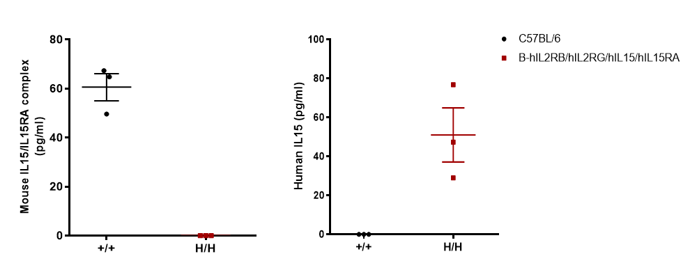
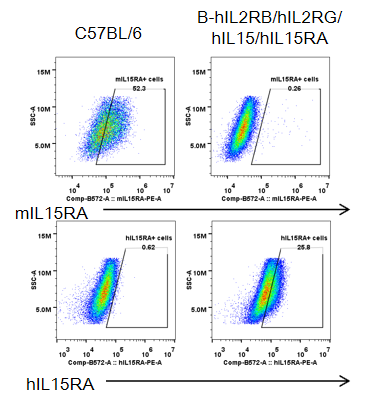
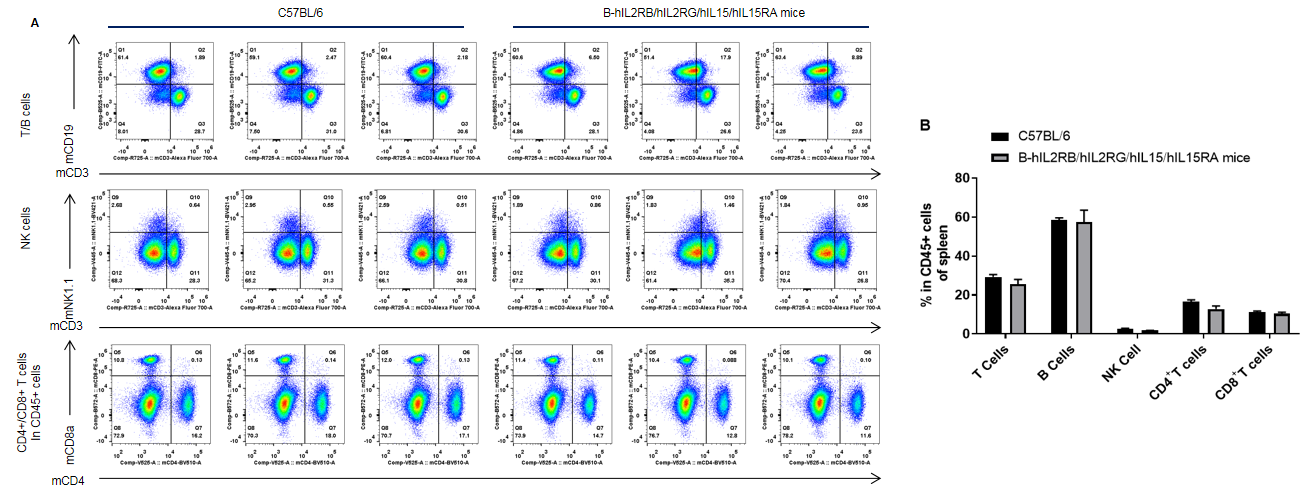


Intracellular phosphorylation of STAT5 analysis in splenocytes by flow cytometry. Splenocytes were harvested and analyzed for pSTAT5 induction in the specified cell types. IL-2 induced pSTAT5 in T cells in a dose-dependent manner, specifically resulting in elevated levels of pSTAT5 in CD8+ T cells and NK cells. At the same concentration, human IL-2 induced a higher level of pSTAT5 in humanized mice compared to wild-type C57BL/6 mice, indicating that the humanized B-hIL2RB/hIL2RG/hIL15/hIL15RA mice are more sensitive to human IL-2.

Intracellular phosphorylation of STAT5 analysis in splenocytes by flow cytometry. Splenocytes were harvested and analyzed for pSTAT5 induction in the specified cell types. The IL-15/IL-15RA complex induced pSTAT5 in T cells in a dose-dependent manner, specifically resulting in a high level of pSTAT5 in CD8+ T cells, while showing no significant effect in CD4+ T cells. Additionally, the mouse IL-15/IL-15RA complex induced lower levels of pSTAT5 in humanized mice compared to the human IL-15/IL-15RA complex at the same concentration.
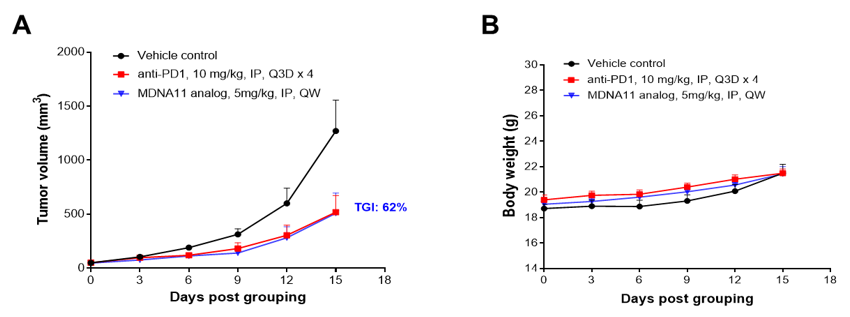
Antitumor activity of a long-acting IL-2 superkine (MDNA11 analog) in B-hIL2RB/hIL2RG/hIL15/hIL15RA mice. MC38 cells were subcutaneously implanted into homozygous mice (female, 6-7 weeks old, n=6). Mice were grouped when tumor volume was approximately 50 mm3, at which time they were treated with drugs in doses and frequency shown in the panel. (A) MC38 tumor growth. (B) Body weight changes during treatment. As shown, MDNA11 analog were efficacious in controlling tumor growth. These mice provide a powerful preclinical model for in vivo evaluation of IL2 therapy molecules. Values are expressed as mean ± SEM.
*The experiment is verified by the cooperation partner. The drugs used here all belong to clients.
The MDNA11 analog does not bind to human IL2RA but exhibits a higher affinity for binding to human IL2RB.

Antitumor activity of a long-acting IL-2 superkine (MDNA11 analog) in B-hIL2RB/hIL2RG/hIL15/hIL15RA mice. MC38 cells were subcutaneously implanted into homozygous mice (female, 6-7 weeks old, n=6). As shown, MDNA11 analog were efficacious in controlling tumor growth.
*The experiment is verified by the cooperation partner. The drugs used here all belong to clients.
The MDNA11 analog does not bind to human IL2RA but exhibits a higher affinity for binding to human IL2RB.
